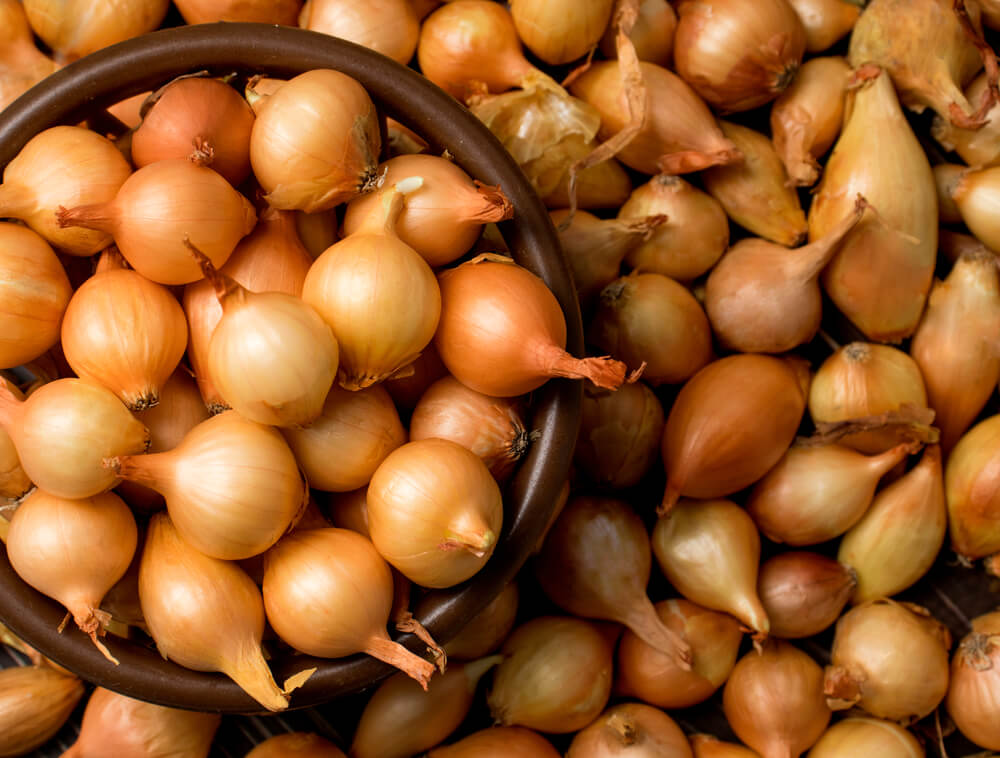How Onions Became a Staple On My Family’s Seder Plate
Every spring, my family gathers around our Passover table, which isn’t complete without a few raw onions.
How Onions Became a Staple On My Family’s Seder Plate
Every spring, my family gathers around our Passover table, which isn’t complete without a few raw onions.

Onions are an essential part of the author's Passover celebration.by Natallia Ustsinava, Shutterstock.
Like most Jewish families, mine has spent years, decades even, crafting our Passover seders. Each time we meet, a new tradition gets folded into the script, and we rejoice in revisiting it for years to come. We’ve included inside jokes, favorite foods, even misheard song lyrics into our celebration. We joyfully cry out the bridge in the L’fichakh (a psalm) as a tribute to my aunts. The grandchildren have nursed cuts and bruises in our yearly quest to find the afikomen. For years, we served pepper steak, a dish no one ate, because my father once innocently asked if it would be there. The serving plate ended up on the table in front of Dad every year after that.
Our Passover seder is uniquely ours, full of bits of family ephemera, accumulated over lifetimes. Over the years, our celebration has morphed from an hours-long dinner to a speedy 45-minute brunch. We’ve moved from my Baba’s old house, where we would pack 50 people around an ever-expanding table. There were about 20 leaves for that table in the closet, and I would shuffle back and forth with my cousins filling it in as my uncle turned the crank on the underside that transformed the heavy wooden behemoth into a true marvel of woodworking. In recent years, we plop on the floor of my aunt’s living room instead, eschewing the table altogether.

Perhaps most important in our Passover celebration, and one of our longest held traditions, is the onion. Including the onions in our ritual is a reminder of how crucial they were to our family. Without onions, none of us would be here.
The traditional Passover seder is a dinner with a fairly rigid agenda. The word seder translates to “order,” so timing is crucial to each part of the meal. Everything is structured: when you say a prayer, when you eat a piece of matzah, when you sing or light candles or take a drink of wine. There’s a specificity to the proceedings, because you’re telling a story—that of the Jews’ exodus from slavery in Egypt.
Part of that retelling involves the seder plate, a centerpiece of the seder. There are five key items on the seder plate, each with a specific meaning. The karpas is the vegetable offering, which signals the arrival of spring and the freedom the Jews found after escaping their bondage. During dinner, the karpas is dipped in saltwater before it’s eaten, to symbolize the tears shed before the Jews fled slavery. While karpas can be any vegetable, it’s generally parsley or lettuce—really, anything green. But for my family, it’s an onion. A raw, sliced, bring-you-to-tears onion.
My grandmother, Freeda Baron, was born in 1921 on a small farm in Edenbridge, Saskatchewan. It was one of Canada’s little-known Jewish farming settlements, and my great-grandparents helped to establish the community there after they emigrated from Europe. While they found some success in farming, it was a hard life. Baba grew up during the height of the Depression and learned to scrimp and save anything useful. The farm was bountiful during the summer, but the prairie winters were especially harsh and long. When Passover rolled around in the early spring, Baba and her siblings didn’t have any green vegetables to contribute to the seder plate. Nothing green had sprouted yet; the ground was often still frozen in places, and spring weather in Saskatchewan was unpredictable. So, they turned to the one vegetable they did have: onions. My Baba grew up dipping onions into saltwater during her seders, and we still do the same, long after our family moved off the farm.

Baba went on to become a teacher, moved to a city, got married and raised her family. She built a life. She built a legacy. Her four children had children of their own, who now have children of their own. Nieces and nephews proliferated. All manner of family friends were grafted onto our family tree and given the title of “cousin,” despite their actual relation.
None of us is a farmer now. I might be the closest we’ve got, writing about agriculture for this very magazine. But, each year, we’re reminded of our direct connection to that farm in Edenbridge. That slice of onion is a reminder of where our family has been and all the work our matriarchs did to bring us forward from that point.
This year, for the third year in a row, I’ll be logging on to Zoom for our virtual seder. Even in the face of COVID-19, our traditions persist. I’ll watch each little pixelated box on the screen fill up with the faces of my family members, spread out in their homes across the world. We’ll sing and laugh and tell jokes. And when it comes time, we’ll each carefully dip our onion slices into the prepared saltwater and think of home.
Follow us
This work is licensed under a Creative Commons Attribution-NoDerivatives 4.0 International License.
Want to republish a Modern Farmer story?
We are happy for Modern Farmer stories to be shared, and encourage you to republish our articles for your audience. When doing so, we ask that you follow these guidelines:
Please credit us and our writers
For the author byline, please use “Author Name, Modern Farmer.” At the top of our stories, if on the web, please include this text and link: “This story was originally published by Modern Farmer.”
Please make sure to include a link back to either our home page or the article URL.
At the bottom of the story, please include the following text:
“Modern Farmer is a nonprofit initiative dedicated to raising awareness and catalyzing action at the intersection of food, agriculture, and society. Read more at <link>Modern Farmer</link>.”
Use our widget
We’d like to be able to track our stories, so we ask that if you republish our content, you do so using our widget (located on the left hand side of the article). The HTML code has a built-in tracker that tells us the data and domain where the story was published, as well as view counts.
Check the image requirements
It’s your responsibility to confirm you're licensed to republish images in our articles. Some images, such as those from commercial providers, don't allow their images to be republished without permission or payment. Copyright terms are generally listed in the image caption and attribution. You are welcome to omit our images or substitute with your own. Charts and interactive graphics follow the same rules.
Don’t change too much. Or, ask us first.
Articles must be republished in their entirety. It’s okay to change references to time (“today” to “yesterday”) or location (“Iowa City, IA” to “here”). But please keep everything else the same.
If you feel strongly that a more material edit needs to be made, get in touch with us at [email protected]. We’re happy to discuss it with the original author, but we must have prior approval for changes before publication.
Special cases
Extracts. You may run the first few lines or paragraphs of the article and then say: “Read the full article at Modern Farmer” with a link back to the original article.
Quotes. You may quote authors provided you include a link back to the article URL.
Translations. These require writer approval. To inquire about translation of a Modern Farmer article, contact us at [email protected]
Signed consent / copyright release forms. These are not required, provided you are following these guidelines.
Print. Articles can be republished in print under these same rules, with the exception that you do not need to include the links.
Tag us
When sharing the story on social media, please tag us using the following: - Twitter (@ModFarm) - Facebook (@ModernFarmerMedia) - Instagram (@modfarm)
Use our content respectfully
Modern Farmer is a nonprofit and as such we share our content for free and in good faith in order to reach new audiences. Respectfully,
No selling ads against our stories. It’s okay to put our stories on pages with ads.
Don’t republish our material wholesale, or automatically; you need to select stories to be republished individually.
You have no rights to sell, license, syndicate, or otherwise represent yourself as the authorized owner of our material to any third parties. This means that you cannot actively publish or submit our work for syndication to third party platforms or apps like Apple News or Google News. We understand that publishers cannot fully control when certain third parties automatically summarize or crawl content from publishers’ own sites.
Keep in touch
We want to hear from you if you love Modern Farmer content, have a collaboration idea, or anything else to share. As a nonprofit outlet, we work in service of our community and are always open to comments, feedback, and ideas. Contact us at [email protected].by Emily Baron Cadloff, Modern Farmer
April 15, 2022
Modern Farmer Weekly
Solutions Hub
Innovations, ideas and inspiration. Actionable solutions for a resilient food system.
ExploreExplore other topics
Share With Us
We want to hear from Modern Farmer readers who have thoughtful commentary, actionable solutions, or helpful ideas to share.
SubmitNecessary cookies are absolutely essential for the website to function properly. This category only includes cookies that ensures basic functionalities and security features of the website. These cookies do not store any personal information.
Any cookies that may not be particularly necessary for the website to function and are used specifically to collect user personal data via analytics, ads, other embedded contents are termed as non-necessary cookies.
Love this!
Thank you!!
This article is being copied to https://proagriculture.in :stop that guy, he is coping your articles plus others’ articles
I prefer baked garlic on the grill, challot with a steak, red onion in salads, and pickled red onion on burgers. Yellow onions with sauce and onion peel for Easter eggs